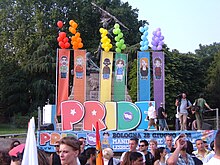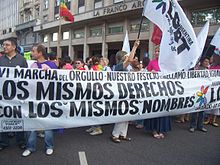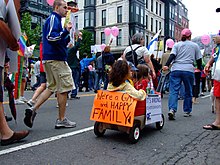What is A Nun In eh Habit but eh Lesbian in Review EAN the Covers On A Priest^steen?? https://en.wikipedia.org/wiki/Steen
LGBT
From Wikipedia, the free encyclopedia
| Part of a series on |
| Lesbian, gay, bisexual, andtransgender (LGBT) people |
|---|
| Sexual orientation |
| History |
| Culture |
| Rights |
| Social attitudes |
| Prejudice / Violence |
| Academic fields and discourse |
LGBT or GLBT is an initialism that stands for lesbian, gay, bisexual, and transgender. In use since the 1990s, the term is an adaptation of the initialism LGB, which was used to replace the term gay in reference to the LGBT community beginning in the mid-to-late 1980s.[2]Activists believed that the term gay community did not accurately represent all those to whom it referred.[3]
The initialism has become mainstream as a self-designation; it has been adopted by the majority of sexuality and gender identity-basedcommunity centers and media in the United States, as well as some other English-speaking countries.[4][5] The term is used also in some other countries, particularly those which languages use the initialism, such as Argentina, France and Turkey.
The initialism LGBT is intended to emphasize a diversity of sexuality and gender identity-based cultures. It may be used to refer to anyone who is non-heterosexual or non-cisgender, instead of exclusively to people who are lesbian, gay, bisexual, or transgender.[3][6] To recognize this inclusion, a popular variant adds the letter Q for those who identify as queer or are questioning their sexual identity; LGBTQhas been recorded since 1996.[7] Those who wish to include intersex people in LGBT groups suggest an extended initialism LGBTI.[8][9]This initialism is used in all parts of "The Activist's Guide" of the Yogyakarta Principles in Action.[10] Some people combine the two acronyms and use the term LGBTIQ.
Whether or not LGBT people openly identify themselves may depend on local political concerns and whether they live in a discriminatory environment, as well as on the status of LGBT rights where they live.[11] Some research, conducted anonymously and online and including the 'Q' category, found that more adolescents and young adults identified as 'Q' (questioning) compared with other LGBTQ categories.[12] That may reflect the uncertainty and external pressures surrounding human sexuality.
Contents
[hide]History
Main articles: LGBT history and Timeline of LGBT history
Further information: Terminology of homosexuality
Before the sexual revolution of the 1960s, there was no common non-derogatory vocabulary for non-heterosexuality; the closest such term, third gender, traces back to the 1860s but never gained wide acceptance in the United States.[13][14][15][16][17][18]
The first widely used term, homosexual, originally carried negative connotations. It was replaced by homophile in the 1950s and 1960s,[19] and subsequently gay in the 1970s; the latter term was adopted first by the homosexual community.[13] Lars Ullerstam promoted use of the term sexual minority in the 1960s,(sv) as an analogy to the term ethnic minority for non-whites.[20]
As lesbians forged more public identities, the phrase "gay and lesbian" became more common.[3] The Daughters of Bilitis folded in 1970 due to disputes over their direction: whether to focus on feminism or gay rights issues.[21] As equality was a priority forlesbian feminists, disparity of roles between men and women or butch and femme were viewed as patriarchal. Lesbian feminists eschewed gender role play that had been pervasive in bars, as well as the perceived chauvinism of gay men; many lesbian feminists refused to work with gay men, or take up their causes.[22]
Lesbians who held a more essentialist view, that they had been born homosexual and used the descriptor "lesbian" to define sexual attraction, often considered the separatist, angry opinions of lesbian-feminists to be detrimental to the cause of gay rights.[23] Bisexual and transgender people also sought recognition as legitimate categories within the larger minority community.[3]
After the elation of change following group action in the Stonewall riots in New York, in the late 1970s and the early 1980s, some gays and lesbians became less accepting of bisexual or transgender people.[24][25] Critics said that transgender people were acting out stereotypes and bisexuals were simply gay men or lesbian women who were afraid to come out and be honest about their identity.[24] Each community has struggled to develop its own identity including whether, and how, to align with other genderand sexuality-based communities, at times excluding other subgroups; these conflicts continue to this day.[25]
From about 1988, activists began to use the initialism LGBT in the United States.[26] Not until the 1990s within the movement did gay, lesbian, bisexual and transgender people gain equal respect .[25] Although the LGBT community has seen much controversy regarding universal acceptance of different member groups (bisexual and transgender individuals, in particular, have sometimes been marginalized by the larger LGBT community), the term LGBT has been a positive symbol of inclusion.[6][25] Despite the fact that LGBT does not nominally encompass all individuals in smaller communities (see Variants below), the term is generally accepted to include those not specifically identified in the four-letter initialism.[6][25] Overall, the use of the term LGBT has, over time, largely aided in bringing otherwise marginalized individuals into the general community.[6][25] Transgender actress Candis Cayne in 2009 described the LGBT community "the last great minority", noting that "We can still be harassed openly" and be "called out on television."[27]
In response to years of lobbying from users and LGBT groups to eliminate discrimination, the online social networking service Facebook, in February 2014, widened its choice of gender variants for users.[28][29] In June 2015, after the US Supreme Court verdict granting equal marriage rights, Facebook introduced a filter allowing users to color their profile pictures rainbow in celebration of LGBT equality.[30]
Variants
Many variants exist including variations that change the order of the letters; LGBT or GLBT are the most common terms and the ones most frequently seen.[25] Although identical in meaning, LGBT may have a more feminist connotation than GLBT as it places the "L" (for "lesbian") first.[25] When not inclusive of transgender people, it is sometimes shortened to LGB.[25][31] LGBT may also include additional "Q"s for "queer" or "questioning" (sometimes abbreviated with a question mark and sometimes used to mean anybody not literally L, G, B or T) producing the variants "LGBTQ" and "LGBTQQ"".[32][33][34] In the United Kingdom, it is sometimes stylized as LGB&T,[35][36] whilst the Green Party of England and Wales uses the term LGBTIQ in its manifesto and official publications.[37][38][39]
The order of the letters has not been standardized; in addition to the variations between the positions of the initial "L" or "G", the mentioned, less common letters, if used, may appear in almost any order.[25] Initialisms related to LGBTQ people are sometimes referred to as "alphabet soup."[40][41] Variant terms do not typically represent political differences within the community, but arise simply from the preferences of individuals and groups.[42]
The terms pansexual, omnisexual, fluid and queer-identified are regarded as falling under the umbrella term bisexual (and therefore are considered a part of the bisexual community). Likewise, the terms transsexual and intersex are regarded by some people as falling under the umbrella term transgender, though many transsexual and intersex people object to this.[25] Some intersex people prefer the initialismLGBTI, while others insist that they are not a part of the LGBT community and would rather that they not be included as part of the term.[9][43] In Australia, where LGBTI is increasingly used,[44][45] and organizations representing cross-community interests have a history of collaboration including through a National LGBTI Health Alliance, anti-discrimination legislation recognizes that intersex is a biological attribute distinct from both gender identity and sexual orientation.[44][46][47][48][49]
SGL ("same gender loving") is sometimes favored among gay male African Americans as a way of distinguishing themselves from what they regard as white-dominated LGBT communities.[50] MSM ("men who have sex with men") is clinically used to describe men who have sex with other men without referring to their sexual orientation.[51][52]
The gender identity "transgender" has been recategorized to trans* by some groups, where trans (without the asterisk) has been used to describe trans men and trans women, while trans* covers all non-cisgender (genderqueer) identities, including transgender, transsexual, transvestite, genderqueer, genderfluid, non-binary, genderfuck, genderless,agender, non-gendered, third gender, two-spirit, bigender, and trans man and trans woman.[53][54]
Other variants may have a "U" for "unsure"; a "C" for "curious"; another "T" for "transvestite"; a "TS", or "2" for "two-spirit" persons; and/or an "SA" for "straight allies".[55][56][57][58][59] However, the inclusion of straight allies in the LGBT acronym has proven controversial as many straight allies have been accused of using LGBT advocacy to gain popularity and status in recent years,[60] and various LGBT activists have criticised the heteronormative worldview of certain straight allies.[61] Some may also add a "P" for "polyamorous", an "H" for "HIV-affected", and/or an "O" for "other".[25][62] Furthermore, the initialism LGBTIH has seen use in India to encompass the hijra third gender identity and the related subculture.[63][64]
The initialism LGBTTQQIAAP (lesbian, gay, bisexual, transgender, transsexual, queer, questioning, intersex, asexual, ally, pansexual) has also resulted, although such initialisms are sometimes criticized for being confusing and leaving some people out, as well as issues of placement of the letters within the new title.[40] However, adding the term "allies" to the initialism has sparked controversy,[65] with some seeing the inclusion of "ally" as opposed to "asexual" a form of asexual erasure.[66] There is also the acronym QUILTBAG(queer and questioning, intersex, lesbian, transgender and two-spirit, bisexual, asexual and ally, and gay and genderqueer).[67]
The magazine Anything That Moves coined the acronym FABGLITTER from fetish (such as the BDSM community), allies or poly-amorous (as in polyamorous relationships), bisexual, gay, lesbian, intersex, transgender, transsexual engendering revolution or inter-racial attraction; however, this term has not made its way into common usage.[3]
Wesleyan University used the initialism LGBTTQQFAGPBDSM for "lesbian, gay, bisexual, transgender, transsexual, queer, questioning, flexual,[clarification needed] asexual, gender-fuck, polyamorous, bondage/discipline, dominance/submission, and sadism/masochism".[68][69]
Criticism of the term
The initialisms LGBT or GLBT are not agreeable to everyone that they encompass.[71] For example, some argue that transgender and transsexual causes are not the same as that of lesbian, gay, and bisexual (LGB) people.[72] This argument centers on the idea that transgender and transsexuality have to do with gender identity, or a person's understanding of being or not being a man or a woman irrespective of their sexual orientation.[25] LGB issues can be seen as a matter of sexual orientation or attraction.[25] These distinctions have been made in the context of political action in which LGB goals, such as same-sex marriage legislation and human rights work (which may not include transgender and intersex people), may be perceived to differ from transgender and transsexual goals.[25]
Many people have looked for a generic term to replace the numerous existing initialisms.[73] Words such as queer (an umbrella term for sexual and gender minorities that are not heterosexual, or gender-binary) and rainbow have been tried, but most have not been widely adopted.[73][74] Queer has many negative connotations to older people who remember the word as a taunt and insult and such (negative) usage of the term continues.[73][74] Many younger people also understand queer to be more politically charged than LGBT.[74][75]"Rainbow" has connotations that recall hippies, New Age movements, and organizations like Jesse Jackson's Rainbow/PUSH Coalition in the United States.
Some people advocate the term "minority sexual and gender identities" (MSGI, coined in 2000), or gender and sexual/sexuality minorities (GSM) so as to explicitly include all people who are not cisgender and heterosexual, or gender, sexual, and romantic minorities (GSRM) which is more explicitly inclusive of minority romantic orientations andpolyamory, but those have not been widely adopted either.[76][77][78][79][80] Other rare umbrella terms are Gender and Sexual Diversities (GSD),[81] MOGII (Marginalized Orientations, Gender Identities, and Intersex) and MOGAI (Marginalized Orientations, Gender Alignments and Intersex).[82][83]
A reverse to the above situations is evident in the belief of "lesbian & gay separatism" (not to be confused with the related "lesbian separatism"), which holds that lesbians and gay men form (or should form) a community distinct and separate from other groups normally included in the LGBTQ sphere.[84] While not always appearing of sufficient number or organization to be called a movement, separatists are a significant, vocal, and active element within many parts of the LGBT community.[73][84][85] In some cases separatists will deny the existence or right to equality of nonmonosexual orientations and of transsexuality.[73] This can extend to public biphobia and transphobia.[73][84] In contrasts to separatists, Peter Tatchell of the LGBT human rights group OutRage! argues that to separate the transgender movement from the LGB would be "political madness", stating that "Queers are, like transgender people, gender deviant. We don’t conform to traditional heterosexist assumptions of male and female behaviour, in that we have sexual and emotional relationships with the same sex. We should celebrate our discordance with mainstream straight norms."[86]
The portrayal of an all-encompassing "LGBT community" or "LGB community" is also disliked by some lesbian, gay, bisexual, and transgender people.[87][88] Some do not subscribe to or approve of the political and social solidarity, and visibility and human rights campaigning that normally goes with it including gay pride marches and events.[87][88]Some of them believe that grouping together people with non-heterosexual orientations perpetuates the myth that being gay/lesbian/bi/asexual/pansexual/etc. makes a person deficiently different from other people.[87] These people are often less visible compared to more mainstream gay or LGBT activists.[87][88] Since this faction is difficult to distinguish from the heterosexual majority, it is common for people to assume all LGBT people support LGBT liberation and the visibility of LGBT people in society, including the right to live one's life in a different way from the majority.[87][88][89] In the 1996 book Anti-Gay, a collection of essays edited by Mark Simpson, the concept of a 'one-size-fits-all' identity based on LGBT stereotypes is criticized for suppressing the individuality of LGBT people.[90]
Writing in the BBC News Magazine in 2014, Julie Bindel questions whether the various gender groupings now, "bracketed together" . . . "share the same issues, values and goals?" Bindel refers to a number of possible new initialisms for differing combinations and concludes that it may be time for the alliances to be reformed or finally we go, "our separate ways".[91]




